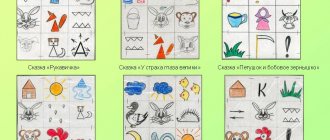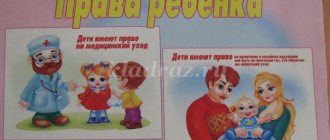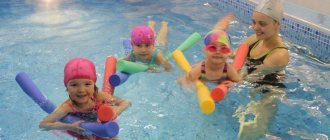Ways to involve children in different activities
Educators often face a problem when a child refuses any type of activity (art, music, joint play, etc.). For example, he does not want to do something together with others, preferring to play alone with his favorite toy. In such situations, various variations in the behavior of an adult are possible.
For example, a teacher insists that a child stop playing with a toy and switch to another activity, doing the same thing as other children. At the same time, the adult seems to have good intentions and wants the child to acquire new knowledge, skills and abilities. However, by insisting on his demand, he suppresses the child’s initiative. Activities in which a child participates at the direction of an adult often turn out to be uninteresting for him - he participates in it only formally. This leads to a person’s passive position, which can be expressed as follows: “An adult always knows better what to do.
Let's consider another option. The teacher always allows the child to do what he likes best and never encourages him to participate in other activities. At first glance, this attitude looks like a manifestation of an individual approach to education. However, a truly individual approach requires creating conditions that allow each person to develop most effectively. A situation where a teacher “leave” a child alone can be used as a temporary measure. The effectiveness of an individual approach to raising a child can be analyzed using the following example.
Every day Olga plays with only one toy - a teddy bear. So, she reproduces the same action (rolling him in a trolley), does not want to be busy with something else, and avoids communicating with peers. In this case, the teacher should try to expand the child’s range of interests, encourage him to engage in new activities, and play with other children.
For example, an adult can invite Olya to build a house for a bear cub, make clay pies, or draw a picture. To involve a girl in playing together with her peers, you can offer to organize a birthday party for the bear cub and invite children. At the "party" they will dance, sing, play outdoor games, etc.
Thus, using gaming techniques, the teacher can involve the child in various types of activities, during which he will learn elementary methods of forming, drawing, constructing, and gain experience communicating with peers. Discussion as a means of resolving conflict situations. The need to correct the actions and behavior of children often arises in various conflict situations, when just a remark is not enough, but its solution should not lead to a new conflict; Children should not forcibly distance themselves from each other, accompanying their actions with reprimands and threats. Violence and aggression beget mutual violence and aggression. An effective way in this case is to discuss with children the problem that may arise either between children or between a child and an adult. The adult helps identify the problem, suggest the best solution, evaluate the result and praise the children for a successful solution.
Characteristics of student-oriented technologies in education
One of the main features that distinguishes all educational technologies is the degree of their focus on the child, their approach to him. Either technology is based on the power of pedagogy, environment and other factors, or it recognizes the child as the main actor - it is person-centered.
The term “approach” is more precise and understandable: it has practical meaning. The term “orientation” reflects a predominantly ideological aspect.
The focus of personality-oriented technologies is the unique, holistic personality of a teenager who strives for maximum realization of his capabilities (self-actualization), is open to new experiences and is able to make informed and responsible decisions in various life situations. The key words of student-oriented educational technologies are “development”, “personality”, “individuality”, “freedom”, “independence”, “creativity”.
Personality is the social essence of a person, the totality of his social qualities and characteristics that he develops throughout his life.
Development is a directed, natural change; through development a new quality is created.
Individuality is the unique originality of a phenomenon, a person; the opposite of ordinary, typical.
Creativity is the process by which a product can be created. Creativity comes from within man himself, from within, and is an expression of our entire existence.
Freedom is the absence of dependence.
Personality-oriented technologies try to find methods and means of teaching and upbringing that correspond to the individual characteristics of each child: they use psychodiagnostic techniques, change the attitudes and organization of children’s activities, use a variety of teaching tools, and rebuild the essence of education.
Personality-oriented technologies oppose the authoritarian, impersonal and soulless approach to the child in traditional pedagogical technologies, create an atmosphere of love, care, cooperation, conditions for creativity and personal self-realization.
But in order to work with each student individually, taking into account...
The entire educational process must be structured differently to take into account its psychological characteristics.
Technologization of the student-oriented educational process involves the special design of educational text, didactic material, methodological recommendations for its use, types of educational dialogue, forms of control over the student’s personal development in the process of acquiring knowledge. Only if there is didactic support that implements the principle of subjectivity in education, can we talk about building a student-oriented process.
In order for the person-centered approach to be in demand by teachers and accepted into mass practice in schools, a technological description of this process is necessary. Yakimanskaya I.S. defines the technology of student-centered learning as the principles of development of the educational process itself and makes certain requirements for texts, didactic materials, methodological recommendations, types of educational dialogue, forms of monitoring the student’s personal development, i.e. to the development of all didactic support for student-centered learning. These requirements are as follows:
- The educational material must reveal the content of the student’s subjective experience, including his previous learning experience; the presentation of knowledge in a textbook (by the teacher) should be aimed not only at expanding its volume, structuring, integration, generalization of subject content, but also at the constant transformation of the student’s existing subjective experience;
- In the learning process, it is necessary to constantly compare the student’s subjective experience with the scientific content of the knowledge given;
- active stimulation of the student to self-valued educational activities, the content and forms of which should provide the student with the opportunity for self-education, self-development, self-expression in the process of acquiring knowledge;
- Design and organize educational materials, allowing students to choose content, type and form when completing assignments and solving problems;
- Identify and evaluate learning pathways that students use independently, sustainably, and productively. The ability to choose a path should be included in the task itself. The textbook (teacher) should be used to encourage students to select and use basic ways of working through educational material;
- When metacognition is introduced, i.e. knowledge about the methods of carrying out educational activities, it is necessary to distinguish between general and specific (subject) teaching methods, taking into account their functions in personality development;
- it is necessary to control and evaluate not only the result, but first of all the learning process, i.e. those transformations that the student undergoes in the process of mastering the subject;
- The educational process must ensure the construction, implementation, reflection and evaluation of learning as a substantive activity. To do this, it is necessary to identify learning units, describe them, and use them to organize teaching by the teacher in the classroom, in individual work (various forms of correction, tutoring).
Implementation of a person-centered approach in the practice of education
Personally-oriented pedagogy means for a teacher not only the creation of a favorable atmosphere, but also a constant appeal to the subjective experience of the student as the experience of his own life activity. The main goal of person-centered education is to reveal the content of each child’s subjective experience, bring it into line with the current tasks of educational work, and on this basis initiate the process of self-education of the child.
How is this approach implemented in the specific conditions of the pedagogical process? The teacher pays special attention to the integration of each student's unique and inimitable subjective experience with real-life activities. The correlation of socially significant and personally significant individual experience occurs in the interaction of the teacher and the child on the basis of balanced initiatives of the adult and the child as equal partners.
The implementation of person-centered education requires the teacher to comply with the following requirements:
- use a variety of methods, techniques, forms, ways of revealing the subjective experience of students, identifying their character traits, tastes, and views;
- rely as much as possible on independent activity, that is, not so much to direct as to organize and direct the activities of children
- involve children in independent or joint setting of educational goals, planning activities
- Encourage children to independently choose and practice socially acceptable behaviors.
- create situations of pedagogical communication in which each student can show initiative, independence and selective behavior
- Provide opportunities for students to express themselves naturally;
- encourage students to express themselves, analyze the motives and methods of their own behavior and the behavior of other students, and make value judgments at the appropriate age level;
- strive to encourage and evaluate not only actions, but also needs, motives, methods of activity, direction of activity and degree of independence.
- involve each child in a discussion of the goals and results of learning, successful steps, reasons for successes and failures, attitude towards the activity (what you wanted to repeat and what you wanted to do differently).
Understanding a child means penetrating into his inner spiritual world. Understanding is based on diagnosing the child’s personality and studying his experience and consists in the fact that the teacher creates on this basis a holistic picture of the child’s personality. Recognition of a child means the child’s right to be himself, the child’s right to respect from an adult. Recognition of a child means that the teacher maintains a balance between the child’s freedom of action, thinking and goal-setting and the reasonable demands placed on him by the teacher and society.
Acceptance of a child is a positive attitude towards him without any conditions on the part of parents and teachers. Accepting a child does not mean abandoning educational requirements, but presupposes such an attitude towards educational tasks and the choice of educational technology that best ensures the development of this particular child.
Fundamentals of personality-oriented interaction between a teacher and children
LARISA TIGISHVILI
Fundamentals of personality-oriented interaction between a teacher and children
Introduction
In recent years, a personality- oriented approach has been conquering the educational space of Russia. Most teaching staff persistently master the theoretical foundations and technology of using this approach in the educational process. Many teachers and heads of educational institutions consider it the most modern methodological orientation in pedagogical activity .
This popularity of the person-centered approach is due to a number of objectively existing circumstances. Firstly, the dynamic development of Russian society requires the formation in a person not so much of a socially typical person, but of a clearly individual one, allowing him to become and remain himself in a rapidly changing society. Secondly, psychologists and sociologists note that today's schoolchildren are characterized by pragmatic thoughts and actions, emancipation and independence, and this, in turn, determines the use of new approaches and methods by teachers interaction with students . Thirdly, the modern school is in dire need of humanizing relations between children and adults, and democratizing its life activities. Hence, the need to build personality-oriented systems for teaching and raising children is obvious.
1. However, awareness of the expediency of reforms alone is not enough to implement them. It would not be superfluous to note that at present there are many blank spots in the study of the possibilities and conditions for using a personality- oriented approach in teaching practice .
In preschool pedagogy, student-centered education received theoretical justification in the research of V. V. Davydova, I. S. Yakimanskaya, L. M. Klarina, L. N. Perelygina, V. A. Petrovsky, and others. R. was involved in developing an approach to building a holistic pedagogical process on a humanistic basis . S. Bure, L. N. Perelygina and others.
The relevance of the personality-oriented approach is explained by the fact that the dynamic development of Russian society requires the formation of a clearly individual, pragmatic, liberated, independent personality capable of navigating a rapidly changing society [7].
is most widely used among the teaching community. The talented teacher considered the principle of an individual approach to children to be fundamental in organizing and educating a group of children. And he was deeply convinced: in order to understand a child and establish the reasons for his behavior, it is necessary to see not only what catches the eye, but also to delve deeper into his characteristics personality , in his motives. He saw the need for systematically keeping a diary, in which the teacher would note characteristic cases of children’s behavior, analyze their actions, attitude towards the team, towards their comrades. A. S. Makarenko also attached special importance to the preschool period of development, since he believed that 90% of the entire educational process is inherent in the child before the age of five.
“ Pedagogical search ” occupies a special place
such
innovative teachers as Sh. A. Amonashvili [5], S. N. Lysenkova [6], I. P. Volkova [6], E. N. Ilyina [17], T. I. Goncharova [6] , O. S. Gazman [11], E. Yu. Sazonov [29], A. A. Dubrovsky [5]. In their practical activities, in a broad sense, the pedagogy of cooperation and community of teachers and students was carried out, the ideals of humanism and democracy were and are being implemented. In the spirit of the organization, these relationships (especially in the system of Sh. A. Amonashvili)
are considered as
person-oriented .
In addition, a reflection of the person-oriented approach is available in the regulatory framework of the Russian Federation. Thus, in the law of the Russian Federation “On Education”
Article 2 calls the first principle of state policy in the field of education “the humanistic nature of education, the priority of universal human values, human life and health, the free development
of the individual... ”. Paragraph 1 of Article 14 determines that the content of education should be focused on ensuring the self-determination of the individual , creating conditions for his self-realization. The same article (paragraph 5)
states that the content of education should promote
mutual understanding and cooperation between people, take into account the diversity of ideological approaches, and promote the realization of students’ rights to free choice of opinions and judgments.
1.1 The concept of a person-centered approach
Scientists-educators , psychologists and methodologists have made various attempts to define the concept of “ person-centered approach ”
.
According to Alekseev a person-centered approach is not just taking into account the characteristics of the subject of learning, it is a different methodology for organizing learning conditions, which does not involve “taking into account”
, but
the “inclusion”
of his
own personal functions or the demand for his subjective experience.
I. S. Yakimanskaya writes: “ Person-centered learning is the kind of learning where the child’s personality , its originality, self-worth are put at the forefront, the subjective experience of each is first revealed and then coordinated with the content of education.”
The goal of personality-oriented education is “to lay in the child the mechanisms of self-realization, self-development, adaptation, self-regulation, self-defense, self-education and others necessary for the formation of an original personal image .”
Functions of student-centered education :
— humanitarian, the essence of which is the recognition of a person’s self-worth and ensuring his physical and moral health, awareness of the meaning of life and an active position in it, personal freedom and the possibility of maximum realization of one’s own potential. By means (mechanisms)
The implementation of this function is understanding, communication and cooperation;
— culture-creative (culture-forming, which is aimed at preserving, transmitting, reproducing and developing culture through the means of education. The mechanisms for implementing this function are cultural identification as the establishment of a spiritual relationship between a person and his people, accepting their values as their own and building one’s own life taking them into account;
- socialization, which involves ensuring the assimilation and reproduction by the individual of social experience necessary and sufficient for a person to enter the life of society.
The implementation of these functions cannot be carried out in conditions of a command-administrative, authoritarian style of relations between the teacher and children . In student-centered education, a different position of the teacher :
— an optimistic approach to the child and his future as the teacher’s desire to see the prospects for the development of personal potential and the ability to maximize his development;
- attitude towards the child as a subject of his own activity, as a person capable of learning not under coercion, but voluntarily, of his own free will and choice, and to show his own activity;
— reliance on personal meaning and interests (cognitive and social)
every child in learning, promoting their acquisition and development.
All teacher -researchers believe that with student-centered the individual himself comes to the fore . Thus, the implementation of a person-centered approach in education is possible subject to the following conditions:
— Availability of comfortable and safe learning conditions;
— Implementation of education of self-regulatory behavior of the individual ;
— Formation and development of thinking;
— Taking into account the level of abilities and capabilities of each student in the learning process.
1.2 Features of the person-centered approach
Let us consider the methodology of the person-centered approach and the associated models of I. S. Yakimanskaya.
Let us recall that, according to I. S. Yakimanskaya, recognizing the child as the main active figure in the entire cognitive process is personality-oriented pedagogy .
I. S. Yakimanskaya believes that under the model of a personality-oriented approach it is necessary to provide the child with greater freedom of choice in the process of cognition. Within its framework, it is not the student who adapts to the established teaching style of the teacher , but the teacher , having a variety of technological tools, coordinates his techniques and methods of work with the cognitive learning style of the child. It is I. S. Yakimanskaya who introduces a fairly complete classification of models of student-centered education , conditionally dividing them into three main ones :
— socio-pedagogical;
— subject-didactic;
- psychological.
Preschool childhood is a very short period in a person’s life, only the first seven years. But they have lasting significance. During this period, development is more rapid and rapid than ever. From a completely helpless being who can do nothing, the baby turns into a relatively independent, active person . All aspects of the child’s psyche receive a certain development, thereby laying the foundation for further growth.
2. The cognitive activity of a preschooler is manifested, first of all, in the child’s ability to accept from an adult and independently set a cognitive task, draw up an action plan, select means and methods for solving it using the most reliable techniques, 2.1 Studying the features of a person-oriented approach with preschool
Humanization of the pedagogical process involves the construction of a person-oriented model of education , changing the form of communication between the teacher and children in the process of traditional types of children's activities and in everyday life. To a greater extent take into account the interests, desires, abilities of the child, strive for cooperation in cognitive, productive, labor, everyday interaction , and for partnership in games.
A personally oriented lesson in a preschool educational institution, in contrast to a traditional one, first of all changes the type of interaction “ teacher-pupil ”
.
The teacher from a command style to cooperation, focusing on analyzing not so much the results as the child’s procedural activity.
The nature of the relationships that develop in the classroom also changes. The main thing is that the teacher must not only provide knowledge, but also create optimal conditions for the development of personality and the activation of the child’s cognitive activity.
The development of the child, the creation of such conditions so that at each lesson cognitive activity is formed, turning him into a subject interested in learning and his own activities. Children work all the time. There is a constant dialogue between teacher and child.
Activities of the teacher
Shows, explains, reveals, dictates, demands, proves, exercises, checks, evaluates. The central figure is an adult. Child development is abstract, incidental!
The organizer of cognitive activity in which the child, relying on joint developments, conducts an independent search. An adult explains, shows, reminds, hints, leads to a problem, sometimes deliberately makes mistakes, advises, consults, prevents. The central figure is the student! The teacher specifically creates a situation of success, empathizes, encourages, instills confidence, systematizes,
interests, forms motives: encourages, inspires and strengthens the child’s authority.
Pupil's activities
A child is an object of learning upon whom the teacher’s . There is only one teacher - the children often do extraneous things. They gain knowledge, skills and abilities through mental capabilities (memory, attention)
.
The child is the subject of the teacher's . The activity comes not from him, but from the child himself. Methods of problem-search and project-based learning of a developmental nature are used.
Teacher - child relationship
The teacher demands , forces, insists. The child adapts, maneuvers, he is a secondary person.
Subjective-subjective. Working with all children , the teacher actually organizes the work of everyone, creating conditions for the development of personal capabilities , including the formation of his reflective thinking and his own opinion.
When preparing and conducting personality-oriented classes , games, conversations, the teacher
rational techniques, means, methods and forms of work individually for everyone.
2.3 Pedagogical technologies based on a student-centered approach
Before we dwell in more detail on student-centered learning technologies, let’s try to understand the concept of technology in general and technological options in the educational process. “Technology” in the broadest sense of the word is the science of craftsmanship.
The technological arsenal of a personality- oriented approach, according to Professor E. V. Bondarevskaya, consists of methods and techniques that meet such requirements as: dialogicality; activity-
creative character; focus on supporting the individual development of the child; providing the student with the necessary space, choice of content and methods of learning and behavior.
Most teacher-researchers tend to include in this arsenal dialogue, playful and reflective methods and techniques, as well as methods of facilitation and pedagogical support of the child’s personality in the process of his self-development and self-realization. The use of a personality- oriented approach in the educational process, as I. S. Yakimanskaya believes [28], is impossible without the use of diagnostic and self-diagnosis methods. St. Petersburg scientists E.I. Kazakova and A.P. Tryapitsyna [18] rightly consider the method of creating success to be the most important means of student-oriented pedagogical activity .
Basic pedagogical technologies based on a student-centered approach:
— Technology of self-development training (Serikov V.V.)
;
— Pedagogy of cooperation ( “penetrating technology”
);
— Pedagogical technologies of adaptive school;
— Humane-personal technology Amonashvili Sh. A.;
— Gaming technologies;
— Developmental learning technologies;
— Problem-based learning;
— Technologies of level differentiation;
— Technology of individual training (individual approach, individualization of training, project method)
;
— Collective way of learning.
conclusions
When planning his work with children in the classroom, the teacher should rely on the following principles for constructing a curriculum:
various tasks , materials, forms of work and methods of action in the classroom based his interests and capabilities);
- flexibility (as the lesson progresses, it is necessary to make necessary changes to the planned plan, based on observations of the children’s activities)
— openness (use of children’s subjective experience in class, feedback)
.
When preparing and conducting person-centered lesson, the teacher must highlight the fundamental directions of his activity, highlighting the child, then the activity, determining his own position.
Appeal to the subjective experience of a preschooler
a) Identifying this experience by asking questions: how did he do it? Why? What did you rely on?
b) Organizing, through mutual examination and listening, the exchange of the content of subjective experience between children .
c) Lead everyone to the right decision by supporting the most correct versions of children on the problem under discussion.
d) Building new material on their basis : through statements, judgments, concepts.
e) Generalization and systematization of the subjective experience of pupils based on contact .
Use of a variety of teaching materials
a) The teacher’s use of various sources of information.
b) Encouraging children to complete problematic tasks.
c) Offer a choice of tasks of various types , types and forms.
d) Encouraging children to choose material that suits their personal preferences .
The nature of pedagogical communication .
a) Respectful and attentive listening.
b) Addressing children by name only.
c) Conversation with children is not condescending , but “eye to eye”
, supporting the conversation with a smile.
d) Encouragement in the child of independence and self-confidence when answering.
Activation of methods of cognitive activity
a) Encouraging children to use different ways of working .
b) Analysis of all proposed methods, without imposing your opinion.
c) Analysis of the actions of each child and only positively.
d) Discussion of the most rational methods - not good or bad, but what is better in a given method.
f) Evaluating both the result and the process.
Pedagogical flexibility
a) Organization a
every child.
b) Providing children with the opportunity to be selective in the types of work, the nature of the material, and the pace of completion.
c) Creating conditions that allow each child to be active and independent.
d) Showing responsiveness to children’s emotions.
e) Providing assistance to children.
A student-oriented approach to teaching is unthinkable without identifying the subjective experience of each child, that is, his abilities and skills in the student’s cognitive activity, the development of his subjectivity and individuality.
In preschool pedagogy, student-centered education received theoretical justification in the research of V. V. Davydova, I. S. Yakimanskaya, L. M. Klarina, L. N. Perelygina, V. A. Petrovsky, and others. R. was involved in developing an approach to building a holistic pedagogical process on a humanistic basis . S. Bure, L.N. Perelygina and others. The works of which I relied on when writing this material.






